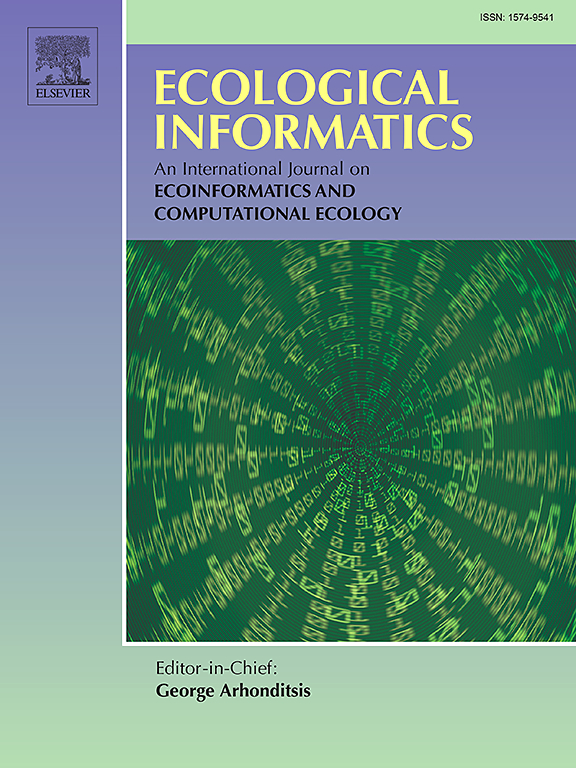PCA-based denoising and automatic recognition of marine biological sounds to estimate Bio-voice Count Index for marine monitoring
IF 7.3
2区 环境科学与生态学
Q1 ECOLOGY
引用次数: 0
Abstract
Passive acoustic monitoring faces methodological challenges when isolating biological signals from anthropogenically dominated marine soundscapes. To address this, we present two novel computational workflows: (1) a Principal Component Analysis (PCA)-driven noise reduction algorithm that selectively suppresses anthropogenic noise (e.g., vessel sounds) overlapping with biological frequency bands; and (2) an automatic Bio-voice Count Index (BCI) that quantifies target biological sounds through energy thresholding and adjustable frequency-weighting curve. We validated these methods using both synthetic soundscapes and 700 min of field recordings from coral reef ecosystems in Sanya, China. The PCA algorithm improved mean signal-to-noise ratios of field recordings by 5.3 dB (from 7.6 dB to 12.9 dB), effectively enhancing biological sound detectability. The BCI demonstrated strong correlations with biological metrics. When combined with the Acoustic Complexity Index, it improved the accuracy of fish abundance estimation compared to single-index approaches. Critically, our method reduces the analysis time by >90 % compared to manual methods. These tools provide ecologists with a reproducible framework for quantifying biodiversity in noisy environments, directly applicable to coral reef health monitoring and anthropogenic impact assessments.

基于pca的海洋生物声去噪与自动识别方法估算海洋生物声计数指数
当从人为主导的海洋声景中分离生物信号时,被动声学监测面临着方法学上的挑战。为了解决这个问题,我们提出了两种新的计算工作流程:(1)主成分分析(PCA)驱动的降噪算法,该算法选择性地抑制与生物频带重叠的人为噪声(例如,血管声音);(2)通过能量阈值和可调节的频率加权曲线对目标生物声音进行量化的自动生物声音计数指数(BCI)。我们使用合成声景和中国三亚珊瑚礁生态系统700分钟的现场录音来验证这些方法。PCA算法将现场录音的平均信噪比提高了5.3 dB(从7.6 dB提高到12.9 dB),有效地提高了生物声音的可探测性。脑机接口与生物学指标有很强的相关性。当与声学复杂性指数相结合时,与单一指数方法相比,它提高了鱼类丰度估计的准确性。关键的是,与手工方法相比,我们的方法减少了90%的分析时间。这些工具为生态学家提供了一个可复制的框架,用于量化嘈杂环境中的生物多样性,直接适用于珊瑚礁健康监测和人为影响评估。
本文章由计算机程序翻译,如有差异,请以英文原文为准。
求助全文
约1分钟内获得全文
求助全文
来源期刊

Ecological Informatics
环境科学-生态学
CiteScore
8.30
自引率
11.80%
发文量
346
审稿时长
46 days
期刊介绍:
The journal Ecological Informatics is devoted to the publication of high quality, peer-reviewed articles on all aspects of computational ecology, data science and biogeography. The scope of the journal takes into account the data-intensive nature of ecology, the growing capacity of information technology to access, harness and leverage complex data as well as the critical need for informing sustainable management in view of global environmental and climate change.
The nature of the journal is interdisciplinary at the crossover between ecology and informatics. It focuses on novel concepts and techniques for image- and genome-based monitoring and interpretation, sensor- and multimedia-based data acquisition, internet-based data archiving and sharing, data assimilation, modelling and prediction of ecological data.
 求助内容:
求助内容: 应助结果提醒方式:
应助结果提醒方式:


